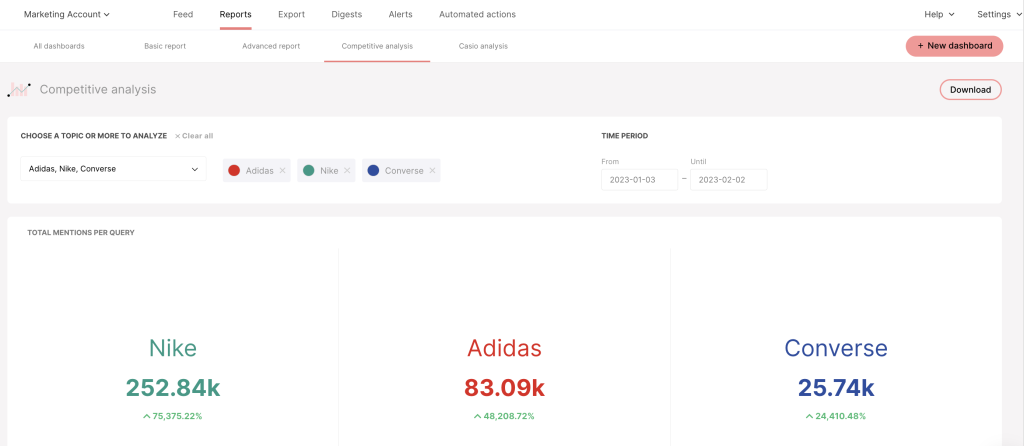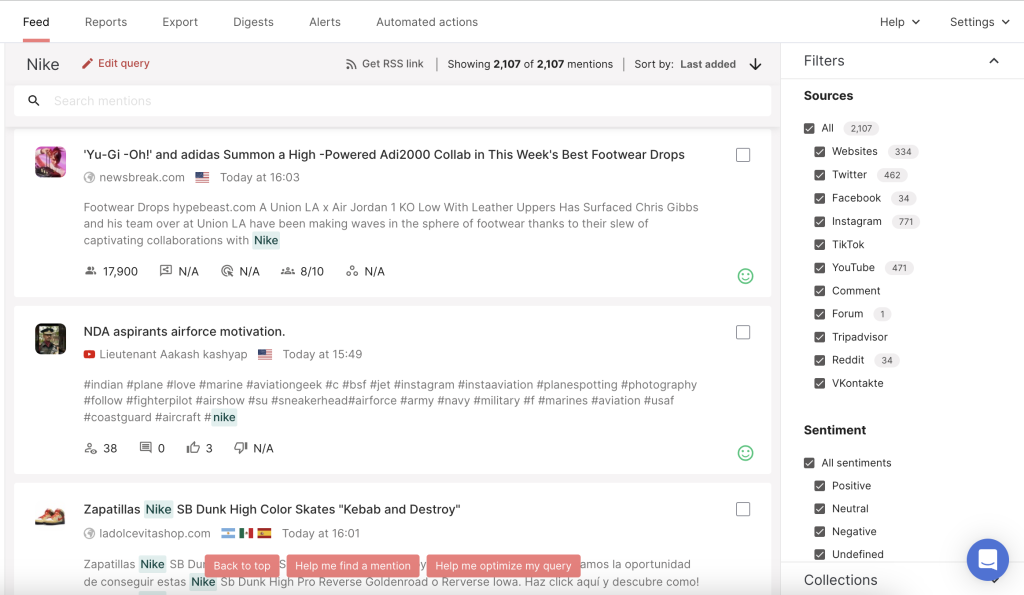There’s one thing that’s a must when creating a business strategy of any kind – you need to take a look at what your competitors are doing.
And there are 2 ways – you can do it manually and go through all their online channels (social platforms, website, media, etc.). Or you can use the power of various online tools available today on the market.
? Read: Competitive Analysis: All You Need to Know
In this blog we’ll explain the difference between competitor and competitive analysis and go through 3 different ways to monitor competitors from scratch with the help of (primarily) media monitoring – one of the most popular ways to monitor competitors today.
Competitor or Competitive Analysis?
No matter if you’re just starting out on your journey with digital marketing or you’re a seasoned pro, you should be familiar with analyzing your competitors’ actions and behaviors on a daily basis.
When speaking about this topic, there are two terms – competitive analysis (which is wider) and competitor analysis (which is narrower), though they’re often used synonymously.
- Competitive analysis is the process by which a company attempts to define and understand its industry, identify its competitors, determine the strengths and weaknesses of its rivals, and anticipate their moves (Zahra & Chaples, 1993).
- Competitor analysis refers to the mere analysis of your competitors’ products, as well as their sales, business and marketing tactics.
Today, however, as many companies are present online, we can develop these terms even further.
Read How to Do a Social Media Competitor Analysis Using Determ

Competitor analysis & media monitoring – how it’s done
To analyze your competition, you need to know more than just a generic description. One of the most popular ways to do it is media monitoring and social listening. Again – these terms are similar, but don’t mean exactly the same things.
- Media monitoring is the process of tracking mentions of keywords connected to your brand on the Internet. You can automate it by using tools that are continuously trawling millions of web sources and gathering relevant data. You’re also provided with details like the author’s name, location, publishing time, sentiment, reach, interactions, engagement rate, and influence score.
- Social listening is the process of reacting to the data gathered during media monitoring and actively adjusting your strategy according to the insights gained into your customers’ behaviour.
Only by combining these two tactics can you achieve the full effects. Luckily, they go hand in hand, so it’s more intuitive and accessible than it sounds!
Why exactly do I need to monitor competitors’ actions & behaviour?
This is probably the first question that popped into your head when thinking about adding a new element to your business strategy. There are multiple reasons:
- It enables making personal interpretations of the gathered data and avoiding crises. That means you can be notified of rivals’ issues right away, collect information, and draw conclusions. After all, it’s cheaper to learn from somebody else’s mistakes than your own.
- When you monitor competitors, you help your managers create strategies based on complex data, not hunches. They can then tackle industry issues better too.
- You can achieve better business performance by paying attention to your competitors’ actions. Doing so allows you to make conscious choices about strategies or SIEM architecture that will strengthen your market position.
- Such analysis enables you to increase sales and ROI thanks to continuous adaptation to market changes.
One thing you should take advantage of when conducting digital marketing is accurate user tracking. You can use this for perfect media monitoring, as there are multiple ways of following your competitors’ actions online.
Read Media Monitoring for Telecommunication Companies
How to Effectively Monitor Competitors
The media monitoring process is based on searching as many sources of information as possible. Therefore, the right tool may take away the burden of looking for data manually. More specifically, automation software takes care of:
- Googling relevant keywords regularly. This is something you could do yourself, but we will take a risk saying that you would have to spend hours to find what the right tool could gather in seconds.
- Tracking online activity on various pages. Don’t limit yourself to Google searches only. You can only get a complete picture of your competitors’ actions when you gather data from sources such as media mentions.
- Using Google Alerts. If you aren’t ready to invest in a media monitoring tool, you can start using this content change detection and notification service. It notifies you via email whenever there are new searches, including websites, press releases, blogs or scientific research connected to chosen keywords.
- Tracking social media activity. If your brand and your competitors run social media profiles, gathering information from these channels is essential (and can be done automatically).
After collecting all of this data, you can compare them to your brand’s performance in a single dashboard (just like on the one below!).

Don’t read tons of content – automate the process
In the 20th century, media monitoring was limited to tracking paper magazines and radio or tv mentions. Today, there are thousands of different content formats on the Internet. As a result, it’s impossible to manually weed out every place where there is a brand mention. And that’s where automation tools can come to the rescue.
What types of content can you track to monitor competitors online?
It’s not only about following your competitor’s company blog, website, and social media profiles. Even scanning their newsletters isn’t sufficient.
With media monitoring tools, you can gather data from all channels and track whether or not your competitors are mentioned on any other websites. All you have to do is set up the right keywords to track and the software will constantly search the Internet for them. You will see the displayed results in a real-time feed without the tiresome work.
Read How to Efficiently Track Mentions Online

Track competitors’ content efforts & analyze their performance
Although there are plenty of them, most digital marketing actions are oriented towards the same goals – ranking better on Google than the competition. To do so, you need to keep an eye on your rivals’ actions and analyze their brand performance.
Why does SEO matter for monitoring competitors’ performance?
This is closely connected to the evaluation of your and your rivals’ SEO results. This acronym stands for Search Engine Optimization and, in a nutshell, it can make your website more visible in search query results pages.
Collecting such data can provide you with information about the backlinks your competitors are obtaining in real-time. Thanks to this, you can discover how your competitors generate traffic. What’s more, you can list what content and social media posts perform best for them and try to rank for similar keywords in the future. This gives you insights into your rivals’ strategies with a focus on driving more organic traffic.
To analyze competitors’ website traffic and compare it to your own, you might have to use special tools like Ahrefs or SE Ranking because you can’t gather this information manually.
How does it work? You can use features like site explorer (to research competitors’ backlinks), keyword explorer (to get inspired plus learn keyword ranking difficulty and traffic potential), or rank tracker (to monitor your own ranking progress).
Read Media Tracking VS Googling: What Gives Better Results?
Speed up your business processes
Media monitoring tools are game-changers for three reasons. They:
- Automate the search process, so you save time and lots of effort compared to doing the same task manually.
- Can search for mentions faster in every corner of the Internet (they’re able to dig deeper than doing so by hand).
- Can process larger amounts of data than any human possibly could.
If you had to do it manually…
Imagine this situation: ten competitors are racing to be the top-of-mind brand in your niche. Each of them posts some content on their social media profile and uploads a few blog posts monthly. Their names and URLs also appear unexpectedly in guest posts and are reviewed on other websites from time to time. And you have to repeat this action over and over every day (including weekends, of course!).
How much time would you spend gathering all this information and how detailed would the data be? How much time would you have left to take care of the other tasks you have to complete?
Read Top 11 Competitor Analysis Tools Every Marketer Should Know
Media monitoring tools in action
The probability of skipping some mentions is greater when gathering them is done by hand for multiple reasons. Media monitoring, same as manual employee monitoring, for example, is a whimsical time stealer that needs your attention 24/7. Do you want to focus all your efforts and dedicate each day to monotonous web crawling to see what your competitors are doing?
That’s basically the purpose of using media monitoring tools. There’s no need to be afraid of automation. Such tools don’t aim to take away jobs, but rather facilitate the daily tasks of your employees.
- With their help, you save time and money by collecting the relevant information regularly, non-stop, and even when you’re asleep.
- Instead of spending hours searching for data, you can focus on the proper interpretation of what you have already collected.
- You don’t have to hire a specialist whose unique task would be to carry out media monitoring every day (or even just a few hours per week).
- You will understand what is working for your competitors thanks to tracking everything they’re doing online.
To Sum Up
Better to do something that isn’t perfect than nothing at all, so the earlier you start using media monitoring, the earlier you will produce satisfactory results. The best option is to choose a tool that lives up to your expectations and allows you to collect all the types of data you need from the beginning.
Why? Because it’s easier and cheaper to invest in a robust solution straight away than to change it after a few months. So before you pick your one and only, try out each option. If you still haven’t checked out what our media monitoring tool Determ can do, why not give it a go and see for yourself how powerful it is?
Start thinking about media monitoring implementation today – the competition never sleeps.



